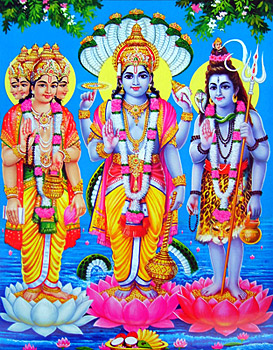The divine trio of Brahma, Vishnu and Maheshwara were born as the unique child of Dattatreya ( three children ,yet not born and were exquisite concept). Later through a boon it was said that this trio would appear as the children of sage Atri and Anusuya. Dattatreya was the assimilation of Somatreya (the manifestation of Brahma) and Durasatreya (the manifestation of Rudra). Being the manifestation of the trinity, Dattatreya possessed the unique symbol of Brahma, the "kamandalu" and "mala", the "trishula" of Shiva and "shankha"; and "charka" of Vishnu. This unique manifestation is said to be the fruit of the consecration of Sati Anusuya, the wife to the sage Atri Maharshi, and deserved to be the parents of the trinity Brahma, Vishnu and Maheshwara.
The Hinduism is emblematized by the symbol "OM" or "AUM" which encompasses the aspect, trinity. The representation of "AUM" connotes Brahma(A), Vishnu (U) and Maheshwara (M).
 Brahma, the absolute and the creator was born in a lotus out of the navel of the sleeping Vishnu. The speech originates from the mind corresponds to Brahma and is also representative of Vak Swarupa and Brihat Swarupa. Brahma is also the primordial sound and is named as Shabda Brahmamayi. The light and darkness is the attribution of Brahma. Brahma created a female form out of his own self, which is known as Gayatri, in order to fabricate the entire Universe. The four heads of Brahma is said to have constructed the four Vedas in Hindu Scripture.
Brahma, the absolute and the creator was born in a lotus out of the navel of the sleeping Vishnu. The speech originates from the mind corresponds to Brahma and is also representative of Vak Swarupa and Brihat Swarupa. Brahma is also the primordial sound and is named as Shabda Brahmamayi. The light and darkness is the attribution of Brahma. Brahma created a female form out of his own self, which is known as Gayatri, in order to fabricate the entire Universe. The four heads of Brahma is said to have constructed the four Vedas in Hindu Scripture.
Vishnu, the preserver, the second God of the tridev and the consort of Devi Laksmi, is portrayed as blue or black skinned and has four arms which bear Sankha , Chakra, Gada and Padma ."Atma" or the mind emerges from mind and as referred to in the dictum "Vishwam Vishnumayam" is also admitted as Vishnu Swarupa. Vishnu is omnipresent and also the mind is. Being the representative of the soul, Vishnu symbolizes the peace and sanctity of "atma" or soul and is the "Mano Swarupa". According to Hinduism, Lord Vishnu descended to earth in the form of "Avatar" to equalize the power of good and evil and set the equilibrium in just form. Vishnu appeared in nine incarnations which are Matsya, Kurma, Varaha, Narasinha, Baman, Ram, Krishna, Buddha and the tenth avatar which is yet to come is Kalki.
The third of the tridev is Maheshwara or Lord Shiva, the better half of Mother Parvati, is presented as white with dark blue throat and three eyes and is known to be the destroyer and also the creator. By the divine dance "tandava", Maheshwara destroys the senile and decayed and out of his power creates regeneration. Lord Shiva as a symbol of creation is worshipped as "Linga".
Brahma`s tongue is the abode of Saraswati , the goddess of knowledge and wisdom. Goddess Lakhsmi , the consort to Lord Vishnu, stands for the compassion aspect of Vishnu. Goddess Parvati is inseparable from Lord Shiva or Lord Shiva presents the image of "Ardhanarishwar"( the half male and the half female form).
The "Hridaya" or "Atma" of a human body is considered to be the abode of the trinity of Brahma, Vishnu and Maheshwara. "Atma" also represents "Eshwara". The trinity pervades the entire cosmos and exists even in the tiniest substance of the world.
The female consorts of the tridevs form a trio force engaging Kali at the centre and Lakshmi and Saraswati at the base points. Forming the basis of the mystical diagrams or "yantras", it serves as an all powerful object of concentration or meditation and also represents the triad principles of creation. The triangle with its crest upwards is indicative of "vahini kona" (the cone of fire) in Tantra, which represents the fire of aspiration that burns in every sadhaka`s heart. On the other hand, the triangle represents the Divine grace of mother, the "yoni" and the origin of all creation, when the crest faces downward. "Sadhana" can be centralized through the transformation of the body into "Yantra". The consecrated body which is the best "yantra", if abused for physical pleasure is considered as a kind of irreverence to God. The human body is the incarnation of the triangular configuration. The six pointed star gets its shape when the woman`s "yoni" forms a downward-pointing triangle and a man`s "lingam" and testicles form an upward-pointing triangle concord with each other. Moreover, a pyramid which is a form of the union of triangle, has great significance in Egyptian, Incan and Mayan cultures. These pyramids are the compositions of the "yantra". Tantra teaches to domesticate the inner energies of a human anatomy and the forces of Nature through "yantra".




















